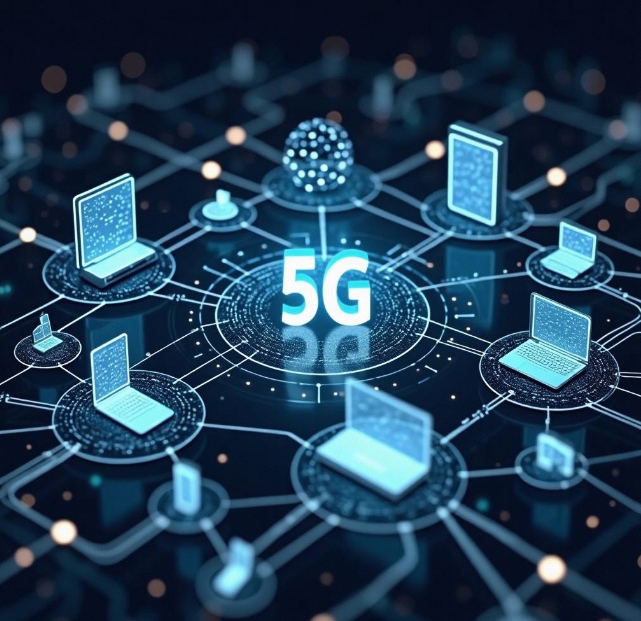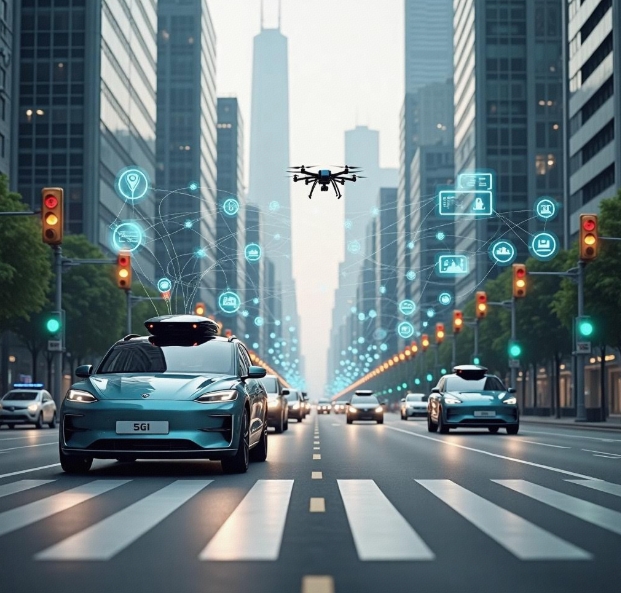Future Development Trends of the Integration of IoT and 5G Technology
- latest articles
- 1.DApp Development & Customization: Merging Diverse Market Needs with User Experience 2.Analysis of the Core Technical System in DApp Project Development 3.How to achieve cross-chain interoperability in Web3 projects? 4.How does the tokenization of points reconstruct the e-commerce ecosystem? 5.How to Set and Track Data Metrics for a Points Mall? 6.What is DApp Development? Core Concepts and Technical Analysis 7.Inventory of commonly used Web3 development tools and usage tips 8.Development of a Distribution System Integrated with Social E-commerce 9.Six Key Steps for Businesses to Build a Points Mall System 10.What is DApp Development? A Comprehensive Guide from Concept to Implementation
- Popular Articles
- 1.Future Trends and Technology Predictions for APP Development in 2025 2.Analysis of the DeFi Ecosystem: How Developers Can Participate in Decentralized Finance Innovation 3.From Zero to One: How PI Mall Revolutionizes the Traditional E-commerce Model 4.DAPP Development | Best Practices for Professional Customization and Rapid Launch 5.How to Develop a Successful Douyin Mini Program: Technical Architecture and Best Practices 6.Recommended by the Web3 developer community: the most noteworthy forums and resources 7.From Cloud Computing to Computing Power Leasing: Building a Flexible and Scalable Computing Resource Platform 8.Shared Bike System APP: The Convenient Choice in the Era of Smart Travel 9.How to Create a Successful Dating App: From Needs Analysis to User Experience Design 10.From Design to Development: The Complete Process of Bringing an APP Idea to Life
In today's rapidly evolving information technology landscape, the integration of the Internet of Things (IoT) and 5G technology has become a major hotspot in the global tech field. The Internet of Things enables data exchange and interconnection between various physical devices via the internet, thereby enhancing our life and work efficiency. As the next generation of communication technology, 5G, with its ultra-high speed, low latency, and large capacity, undoubtedly provides a solid foundation for the popularization and development of IoT. With the gradual deployment of 5G networks, IoT development is encountering new opportunities, and the deep integration of the two will have a profound impact on various industries.
This article will explore the future development trends of the integration of IoT and 5G technology, analyze the potential of their convergence, envision the revolutionary changes they may bring, and introduce some typical application areas.
I. Deep Integration of IoT and 5G Technology
1.1 Current Status and Challenges of IoT
The Internet of Things refers to connecting physical devices to the internet via networks, forming a vast ecosystem of "interconnection of all things." Industries such as smart homes, intelligent transportation, industrial automation, and smart healthcare are typical representatives of IoT applications. However, the rapid development of IoT also brings many challenges. Firstly, the number of IoT devices is enormous, with global IoT devices already reaching tens of billions. How to efficiently manage these devices and ensure their stable and secure operation is an urgent problem to solve.
Secondly, the communication needs among IoT devices are very diverse, including both low-bandwidth, low-power applications and those requiring extremely high real-time performance. Therefore, existing communication technologies face certain bottlenecks in meeting these demands. Especially in remote control, large-scale data transmission, and low-latency applications, the current 4G networks are no longer fully adequate for the development needs of IoT.
1.2 Advantages of 5G Technology
As the fifth-generation mobile communication technology, 5G's most significant features compared to previous generations are its ultra-high speed, low latency, and massive connectivity capabilities. 5G technology can achieve transmission speeds of up to 10Gbps, 100 times faster than 4G; its latency can be reduced to 1 millisecond, almost real-time; simultaneously, 5G networks can support up to 1 million device connections per square kilometer, far exceeding 4G's thousands of devices. These characteristics make 5G an ideal infrastructure for IoT development.
1.3 Integration of IoT and 5G
The integration of IoT and 5G technology can fully leverage their respective advantages. Firstly, 5G's ultra-high bandwidth and low latency can meet IoT's demands for large data transmission and real-time requirements. Secondly, 5G's ultra-high connection density makes the access of large-scale IoT devices more feasible, especially in scenarios like smart cities and smart factories, where 5G will be able to support connections for millions or even tens of millions of devices. Through 5G technology, IoT devices can achieve faster and more stable communication, thereby providing a more solid technical foundation for IoT applications.
II. Typical Application Scenarios of IoT and 5G Integration
With the gradual commercialization of 5G technology, the integration of IoT and 5G will have a profound impact across various industries. The following are some typical application scenarios.
2.1 Intelligent Transportation and Autonomous Driving
Intelligent transportation and autonomous driving are one of the important application scenarios of IoT and 5G integration. Through IoT devices, urban transportation systems can achieve intelligent management, obtaining real-time traffic flow, road conditions, accident information, etc., thereby optimizing traffic scheduling, reducing congestion, and improving travel efficiency. The low latency and high bandwidth of 5G can support real-time communication between autonomous vehicles, enabling the autonomous driving system to respond to environmental changes within milliseconds, thus ensuring driving safety.
Additionally, 5G technology can support the widespread application of the Internet of Vehicles, enabling seamless interconnection between vehicles and between vehicles and road infrastructure through real-time data transmission. For example, 5G can facilitate information sharing between vehicles, warn of traffic accidents, and adjust traffic flow through smart traffic lights to avoid congestion and accidents.
2.2 Smart Healthcare
Smart healthcare is one of the important development directions of IoT and 5G integration. In traditional healthcare models, patients need to go to hospitals for examinations and treatments, and the distribution of medical resources is often uneven, especially in remote areas where the lack of quality medical resources affects the health of many patients. However, through IoT devices, doctors can monitor patients' physical conditions in real time and transmit health data to hospitals for remote diagnosis and treatment. The low latency and large bandwidth of 5G can ensure the timeliness and accuracy of data transmission, improving the effectiveness of remote diagnosis.
For example, 5G can support remote surgery, allowing surgeons to perform precise operations on patients remotely through high-quality video transmission. Furthermore, 5G can support the widespread use of smart wearable devices and health monitoring instruments, enabling real-time monitoring of patients' health data, thereby enhancing the efficiency of disease prevention, diagnosis, and treatment.
2.3 Smart Manufacturing and Industrial Internet
Smart manufacturing and the Industrial Internet are another important application area for the integration of IoT and 5G technology. With the advancement of industrial automation, more and more enterprises are applying IoT technology for intelligent management of production lines. For instance, through sensors and robots, production lines can monitor equipment operating status in real time, predict equipment failures, and optimize production processes. The high speed and low latency of 5G technology can make communication between these devices more efficient and stable.
In smart manufacturing, 5G can support the connection of more devices, enhancing production efficiency and reducing costs. For example, automated equipment, robots, sensors, and data acquisition systems in factories can achieve real-time data transmission and remote control via 5G networks. Additionally, 5G networks can support edge computing for industrial equipment, enabling factories to conduct production scheduling and quality control more intelligently.
2.4 Smart Homes
Smart homes are an important area of IoT application, where various devices in the home can interconnect and achieve intelligent management through IoT technology. For example, smart speakers, smart air conditioners, smart lighting, and other devices can automatically adjust their working states based on user needs. 5G technology can provide a faster and more stable network environment for smart homes, making communication between devices smoother and the user experience more comfortable.
Through 5G networks, smart home devices can achieve more complex scenario linkages, and the management system of smart homes can also perform remote control and data analysis via cloud computing, thereby enhancing the intelligence level of home life. For example, via 5G networks, all smart devices in a home can synchronize user needs in real time, providing more personalized services.
III. Challenges Facing the Integration of IoT and 5G
Although the integration of IoT and 5G technology has broad prospects, there are still some challenges in practical application.
3.1 Network Security Issues
With the surge in the number of IoT devices and the increase in data transmission demands, network security has become a critical problem to solve. IoT devices are often massive and widely distributed, making them easy targets for hacker attacks. Although 5G technology can provide high-speed network services, it also brings more complex network security issues. How to ensure the security of IoT devices and prevent data leaks and malicious attacks has become a major challenge in the process of integrating IoT and 5G.
3.2 Data Privacy Issues
IoT devices collect a large amount of user personal data, including sensitive information such as health status, location information, and consumption habits. With the support of 5G networks, data transmission speeds will significantly increase, but this also raises the risk of data misuse. Therefore, ensuring user data privacy protection and establishing effective privacy protection regulations have become issues that cannot be ignored in the integration of IoT and 5G.
3.3 Technical Standardization and Compatibility Issues
The standardization of IoT and 5G technology is also a major challenge currently faced. Due to the variety of IoT devices and the lack of unified technical standards, compatibility between devices produced by different manufacturers is poor, which can lead to ineffective interconnection. The development of 5G technology also faces issues of diverse technical standards. How to establish unified technical standards and ensure compatibility between different devices and networks is key to promoting the integration of IoT and 5G.
IV. Future Outlook
With the continuous deployment of 5G networks and the ongoing development of IoT technology, their integration will drive transformations in many industries. Areas such as smart cities, smart healthcare, intelligent transportation, and smart homes will undergo more profound changes. The combination of IoT and 5G will make life more intelligent, efficient, and convenient. However, achieving this goal requires efforts in technology research and development, standard setting, policy support, and more.
In the future, as 5G technology becomes more widespread, the application scenarios of IoT will become broader, and the level of intelligence will continuously improve. We can foresee that the deep integration of IoT and 5G technology will bring a more intelligent future to society, promote the digital transformation of the economy, and enhance the quality of human life.
Conclusion
The integration of IoT and 5G technology paints a future full of imagination for us. Whether in smart homes, autonomous driving, the Industrial Internet, or smart healthcare, the fusion of the two will bring more efficient and convenient ways of living and working. However, this process still faces many challenges that require joint efforts from all parties. In the near future, we can look forward to a more intelligent, interconnected, and efficient world.
-

How to Use IoT Development to Enhance Supply Chain Efficiency
With the rapid development of the global economy and the deepening of digital tr···
-

Development and Innovation of the Internet of Things in the Healthcare Sector
With the rapid advancement of information technology, the Internet of Things (Io···
-

Data Storage and Analysis Methods in IoT Development
The Internet of Things (IoT) is one of the most revolutionary innovations in tod···

 Blockchain
Blockchain












